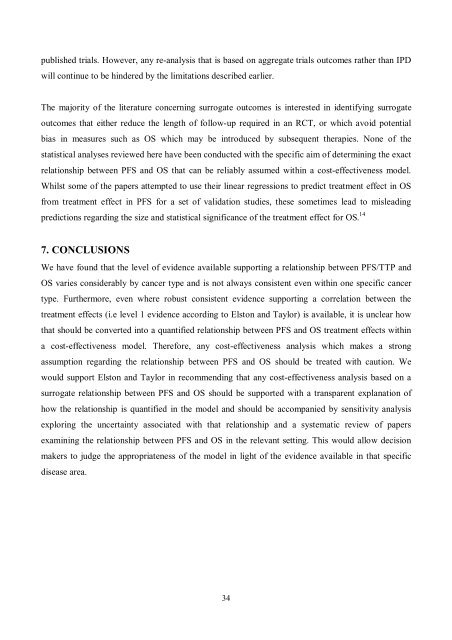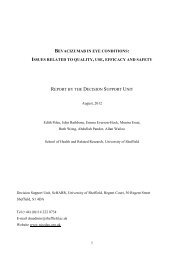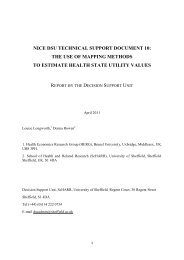A review of studies examining the relationship between progression ...
A review of studies examining the relationship between progression ...
A review of studies examining the relationship between progression ...
You also want an ePaper? Increase the reach of your titles
YUMPU automatically turns print PDFs into web optimized ePapers that Google loves.
published trials. However, any re-analysis that is based on aggregate trials outcomes ra<strong>the</strong>r than IPDwill continue to be hindered by <strong>the</strong> limitations described earlier.The majority <strong>of</strong> <strong>the</strong> literature concerning surrogate outcomes is interested in identifying surrogateoutcomes that ei<strong>the</strong>r reduce <strong>the</strong> length <strong>of</strong> follow-up required in an RCT, or which avoid potentialbias in measures such as OS which may be introduced by subsequent <strong>the</strong>rapies. None <strong>of</strong> <strong>the</strong>statistical analyses <strong>review</strong>ed here have been conducted with <strong>the</strong> specific aim <strong>of</strong> determining <strong>the</strong> exact<strong>relationship</strong> <strong>between</strong> PFS and OS that can be reliably assumed within a cost-effectiveness model.Whilst some <strong>of</strong> <strong>the</strong> papers attempted to use <strong>the</strong>ir linear regressions to predict treatment effect in OSfrom treatment effect in PFS for a set <strong>of</strong> validation <strong>studies</strong>, <strong>the</strong>se sometimes lead to misleadingpredictions regarding <strong>the</strong> size and statistical significance <strong>of</strong> <strong>the</strong> treatment effect for OS. 147. CONCLUSIONSWe have found that <strong>the</strong> level <strong>of</strong> evidence available supporting a <strong>relationship</strong> <strong>between</strong> PFS/TTP andOS varies considerably by cancer type and is not always consistent even within one specific cancertype. Fur<strong>the</strong>rmore, even where robust consistent evidence supporting a correlation <strong>between</strong> <strong>the</strong>treatment effects (i.e level 1 evidence according to Elston and Taylor) is available, it is unclear howthat should be converted into a quantified <strong>relationship</strong> <strong>between</strong> PFS and OS treatment effects withina cost-effectiveness model. Therefore, any cost-effectiveness analysis which makes a strongassumption regarding <strong>the</strong> <strong>relationship</strong> <strong>between</strong> PFS and OS should be treated with caution. Wewould support Elston and Taylor in recommending that any cost-effectiveness analysis based on asurrogate <strong>relationship</strong> <strong>between</strong> PFS and OS should be supported with a transparent explanation <strong>of</strong>how <strong>the</strong> <strong>relationship</strong> is quantified in <strong>the</strong> model and should be accompanied by sensitivity analysisexploring <strong>the</strong> uncertainty associated with that <strong>relationship</strong> and a systematic <strong>review</strong> <strong>of</strong> papers<strong>examining</strong> <strong>the</strong> <strong>relationship</strong> <strong>between</strong> PFS and OS in <strong>the</strong> relevant setting. This would allow decisionmakers to judge <strong>the</strong> appropriateness <strong>of</strong> <strong>the</strong> model in light <strong>of</strong> <strong>the</strong> evidence available in that specificdisease area.34





